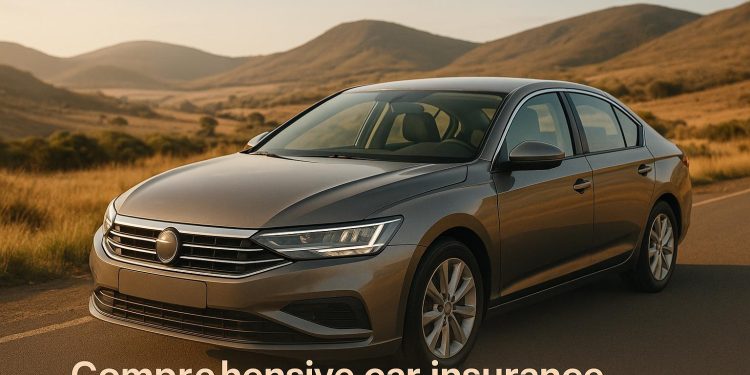Driving in South Africa in 2025 comes with risks – rising vehicle theft, accidents, and repair costs make car insurance more important than ever. Comprehensive policies offer protection against accidents, theft, fire, natural disasters, and third-party liability, ensuring financial security when the unexpected happens.
Here’s what you need to know:
- Coverage Options: Third-party, third-party fire & theft, and comprehensive insurance. Comprehensive plans provide the broadest protection but come with higher premiums ($150–$400/month).
- Key Features: Accident repairs, theft protection, fire damage, and natural disaster coverage. Add-ons like roadside assistance and rental cars are common.
- New in 2025: Telematics rewards safe driving, mobile apps speed up claims, and usage-based pricing lowers costs for low-mileage drivers.
- Regulatory Updates: Clearer exclusions, mandatory cooling-off periods, and stricter rules on premium hikes.
Top Providers like Santam, Old Mutual iWYZE, and Discovery Insure offer competitive plans with perks like driving rewards, flexible excess options, and fast claims processing. Choosing the right policy depends on your car’s value, driving habits, and location. Always review exclusions and compare quotes to avoid surprises.
The Future of Car Insurance in SA! 🚀 Don’t Choose Your Plan Until You Watch This!
What Car Insurance Covers
Understanding what your car insurance covers is crucial to avoid surprises when filing a claim. Comprehensive coverage, in particular, goes well beyond the basic legal requirements, offering protection against a variety of risks that South African drivers face daily.
Coverage Details
Comprehensive insurance provides extensive protection for your vehicle and finances. Here’s what it typically includes:
- Accident Damage: Whether you’re at fault or not, this covers the cost of repairs or even a full replacement of your vehicle at market value.
- Theft Protection: Given the high theft and hijacking rates in South Africa, this is a critical feature. It covers your car’s market value if stolen or damaged during an attempted theft.
- Fire Damage: This includes accidental fires, as well as those caused by riots or civil unrest.
- Natural Disasters: Hailstorms, floods, falling trees, and other severe weather events are covered – something increasingly important as extreme weather becomes more frequent.
- Vandalism: Protects against damage caused intentionally by others, from key scratches to smashed windows or more severe acts of sabotage.
- Third-Party Liability: If you cause damage to someone else’s property or injure another person in an accident, this covers legal costs and compensation – expenses that can add up quickly in serious cases.
Comprehensive insurance often comes with additional perks like windscreen and glass coverage that won’t affect your no-claims bonus, emergency roadside assistance, and even a courtesy car while yours is being repaired.
However, it’s not all-inclusive. Exclusions typically include mechanical failures, normal wear and tear, damages caused while driving under the influence, reckless driving, racing, or using the car for undeclared commercial purposes.
Policy Types Compared
Car insurance in South Africa generally falls into three main categories:
- Third-Party Only: This is the bare minimum required by law. It covers damage or injury you cause to others but offers no protection for your own vehicle. While it’s the cheapest option (monthly premiums range from $50 to $100), it leaves you vulnerable to significant financial risks.
- Third-Party, Fire, and Theft: This adds coverage for your own car in cases of fire or theft, while still including third-party liability. It’s a middle-ground option, costing more than basic third-party insurance (around $80 to $150 per month), but it doesn’t cover accident damage to your car, vandalism, or natural disasters.
- Comprehensive Insurance: This is the most extensive option, covering all the risks mentioned earlier. While it comes with the highest premiums ($150 to $400 per month), it provides peace of mind and financial security.
| Coverage Type | Own Vehicle Accident | Theft | Fire | Natural Disasters | Third-Party Liability | Monthly Premium Range |
|---|---|---|---|---|---|---|
| Third-Party Only | ❌ | ❌ | ❌ | ❌ | ✅ | $50 – $100 |
| Third-Party Fire & Theft | ❌ | ✅ | ✅ | ❌ | ✅ | $80 – $150 |
| Comprehensive | ✅ | ✅ | ✅ | ✅ | ✅ | $150 – $400 |
When Comprehensive Insurance Makes Sense
For those financing a vehicle, comprehensive insurance is often non-negotiable, as banks require it to safeguard their investment. It’s also a smart choice for newer cars or vehicles valued over $15,000, where the cost of replacement would be significant.
Living or working in high-crime areas makes comprehensive coverage almost indispensable. The risk of theft or hijacking in these regions outweighs the additional premium. Similarly, if you rely heavily on your car for commuting or business, comprehensive coverage ensures you’re not left stranded by unexpected events.
The financial consequences of insufficient coverage can be devastating. Imagine losing your car in an accident or theft and still being responsible for loan payments. Comprehensive insurance eliminates this risk, making it the preferred option for most South African drivers who can manage the higher premiums.
Benefits and New Features in 2025
Main Benefits
Comprehensive car insurance offers solid financial protection, giving you peace of mind when unexpected events like accidents, theft, or liability claims arise. Its biggest advantage? It helps cover repair or replacement costs, saving you from hefty out-of-pocket expenses that could disrupt your finances.
Many policies also come with emergency services, such as roadside assistance, to help you get back on track quickly when something goes wrong. These essential benefits lay the groundwork for the exciting updates introduced in 2025.
2025 Updates
In 2025, insurance providers rolled out new features designed to improve both value and convenience. Telematics technology now plays a bigger role, tracking driving behavior to reward safe habits with discounts. Plus, mobile apps have been introduced to streamline claims, speeding up approvals so you can get back on the road faster.
Policyholders also have access to more customizable options than ever before. These include extended roadside assistance, rental car coverage, and gap protection for financed vehicles. Additionally, usage-based pricing has become more common, offering reduced premiums for drivers who log fewer miles. These updates make insurance coverage more flexible and tailored to individual needs. Here’s a quick comparison of the enhanced features:
Enhanced Features Comparison
| Coverage Aspect | Third-Party Only | Third-Party Fire & Theft | Comprehensive |
|---|---|---|---|
| Emergency Services | Limited or none | Typically limited | 24/7 roadside assistance |
| Rental Car Provision | Not included | Sometimes available | Often included |
| Telematics Discounts | Rarely offered | Occasionally available | Frequently provided |
| Digital Claims Processing | Basic | Standard | Advanced, mobile-enabled system |
| Usage-Based Pricing | Not available | Limited availability | Widely available |
| Customizable Add-ons | None | Limited options | Extensive customization options |
| Deductible/Excess | Variable | Variable | Typically lower deductibles |
This table highlights how comprehensive insurance stands out with its broader protection and added perks. While it may come with a higher price tag, the extensive coverage can be a financial lifesaver when the unexpected happens.
Rules and Market Changes in 2025
New Rules
In 2025, South Africa’s insurance sector saw some important regulatory changes aimed at strengthening consumer protection and improving transparency. The Financial Sector Conduct Authority (FSCA) introduced new measures requiring insurers to clearly outline policy exclusions and limitations. This ensures customers are fully aware of any gaps in their coverage.
Another significant update is the introduction of a mandatory cooling-off period for comprehensive insurance policies. This gives policyholders time to review their coverage and cancel if it doesn’t align with their needs. Additionally, insurers now face stricter rules when it comes to premium increases – any hike beyond inflation must be clearly justified. Minimum coverage standards have also been adjusted to better meet consumer demands.
These updates are expected to encourage further advancements in the market.
Market Changes
The South African insurance industry continues to adapt to a rapidly changing world, with digital transformation playing a central role. Many insurers now provide mobile apps that allow customers to manage their policies entirely online – whether it’s filing claims, tracking repairs, or updating coverage details.
Telematics and usage-based insurance models have become increasingly popular. By monitoring driving behavior, insurers can offer more personalized coverage and reward safe drivers with potential premium reductions.
The rise of electric and hybrid vehicles has also led to the creation of specialized policies. These policies address unique needs, such as coverage for batteries and charging equipment. Meanwhile, artificial intelligence is helping to streamline claims processes, with some insurers using digital tools to assess minor damages quickly and efficiently.
Lastly, as climate change continues to influence weather patterns, insurers are adjusting their pricing models to account for regional risks and are expanding coverage options for weather-related damages. These changes reflect the industry’s efforts to stay ahead of evolving challenges and consumer needs.
sbb-itb-09752ea
How to Pick the Right Policy
What to Consider
Selecting the best comprehensive car insurance policy means weighing several important factors that affect both your coverage and costs. Start by considering your vehicle’s age, make, and model. Newer or luxury cars typically come with higher premiums, while older vehicles may only need coverage that matches their current market value.
Next, think about how often you drive and where. If you use your car for business or live in a city with higher theft rates, you may need more extensive coverage.
Another key consideration is the excess (the amount you pay out of pocket when filing a claim). Opting for a higher excess can lower your premiums, but it also means you’ll pay more if you need to claim. Some drivers in South Africa prefer flexible excess structures, where, for instance, the excess for theft is different from that for accident damage.
Lastly, research the insurer’s reputation. Look into their financial stability, claims history, and how quickly they process claims. Once you’ve reviewed these factors, online comparison tools can help simplify your decision-making.
Quote Comparison Tools
Online comparison platforms make it easy to gather multiple insurance quotes at once, saving you the hassle of visiting individual websites. These tools usually require basic information about your vehicle and driving habits to generate quotes quickly. Be sure to provide accurate details so the quotes you receive reflect real-world pricing.
When comparing quotes, don’t just focus on the premiums. Policies with similar costs can differ in benefits, excess terms, and claim processes. Look for platforms that break down coverage details, including optional extras like roadside assistance, rental car coverage, or protection for personal belongings.
Mobile-friendly comparison tools are especially convenient. Many apps not only let you compare quotes but also allow you to manage policies, track claims, and access digital policy documents directly from your smartphone.
Once you’ve narrowed down your options, it’s time to dive into the policy documents for a closer look.
Reading Policy Documents
Reading the fine print of policy documents is crucial. Pay attention to exclusions, such as claims denied for incidents involving driving under the influence, racing, or illegal activities.
Take note of the excess structure. Some policies may include additional excess charges for high-risk drivers or specific types of damage, which could lead to unexpected out-of-pocket costs.
Policy documents also outline the claims process, required documentation, and emergency contact details. Familiarize yourself with these to avoid surprises when filing a claim.
Finally, check for details on coverage limits, geographic restrictions, and renewal terms. This will help you understand payout caps and how your premiums might change in the future.
Top Car Insurance Companies in South Africa
As we dive deeper into the 2025 car insurance market in South Africa, it’s clear that a handful of providers are shaping the landscape with their unique offerings. Whether you’re prioritizing affordability, digital convenience, or comprehensive coverage, there’s something for everyone.
Main Providers
The South African car insurance market in 2025 is dominated by established names, each bringing its own strengths to the table. Here’s a closer look at what they offer:
Santam
With over a century of experience, Santam remains a trusted name in the industry. Their comprehensive policies cover accident damage, theft, and third-party liability as standard. They also provide optional extras like emergency roadside assistance and rental car coverage. What sets them apart is their vast network of approved repair shops and their reputation for smooth claims processing.
Old Mutual iWYZE
Old Mutual iWYZE takes a tech-forward approach, offering competitive pricing and features like gradual premium reductions for claim-free periods and flexible excess options. Their mobile app is a standout, letting policyholders manage their insurance, submit claims with photos, and track repair progress in real-time.
MiWay
MiWay keeps things simple with transparent pricing and straightforward coverage. Their policies include perks like fixed premiums for the first year, no penalties for the first accident, and coverage for personal belongings in the car. Their online platform makes it easy to get quotes and manage policies without the hassle of paperwork.
Discovery Insure
Discovery Insure incorporates DQ-Track technology to monitor driving behavior, offering personalized premiums and rewards for safe driving. Their comprehensive coverage includes standard protections, plus extras like fuel rewards and access to Discovery’s broader ecosystem of benefits.
Outsurance
Known for competitive rates and fast claims processing, Outsurance offers comprehensive coverage with features like accident forgiveness and protection for modifications. They also have a strong network of preferred service providers, ensuring quality repairs and services.
Provider Comparison Table
| Provider | Monthly Premium Range* | Highlights | Digital Tools | Unique Benefits |
|---|---|---|---|---|
| Santam | $45 – $120 | Extensive repair network, emergency assistance | Online portal, mobile app | 100+ years experience, wide service network |
| Old Mutual iWYZE | $40 – $110 | Flexible excess, gradual premium reduction | Advanced mobile app | Real-time repair tracking, claim-free rewards |
| MiWay | $42 – $115 | Fixed first-year premiums, first accident forgiveness | Online management, quote tools | No penalty for first accident, transparent pricing |
| Discovery Insure | $48 – $125 | DQ-Track behavioral monitoring | Comprehensive app ecosystem | Driving behavior discounts, fuel benefits |
| Outsurance | $44 – $118 | Accident forgiveness, modification coverage | Online platform, claims tracking | Quick processing, preferred service providers |
*Premium ranges are estimates for a mid-range vehicle with standard coverage. Actual costs may vary based on individual circumstances, vehicle type, and location.
Each provider brings something different to the table, catering to a variety of driver needs and budgets. Whether it’s claims efficiency, digital tools, or added perks, there’s plenty to consider. Take your time to weigh the options and choose the provider that best aligns with your priorities and the latest 2025 market trends.
Conclusion: Making Better Insurance Choices in 2025
Choosing insurance in South Africa’s 2025 market is about more than just the lowest price. With new regulations, advanced digital tools, and evolving coverage options, your decision can have a big impact on your financial security when it matters most.
Take a close look at the benefits of comprehensive coverage. Unlike basic third-party policies, comprehensive insurance protects against a wider range of risks – something especially important for South African drivers. With concerns like vehicle-related crime and increasingly severe weather events, this type of coverage is essential for safeguarding your investment.
The insurance market now offers both opportunities and challenges. Features like telematics-based pricing and AI-powered claims processing bring greater personalization and efficiency, but they can also make comparing policies more complex. As covered earlier, different providers stand out for various reasons, offering perks tailored to specific driving habits and budgets.
Your choice should reflect your personal needs. Some insurers focus on real-time updates through mobile apps, while others emphasize transparency in their terms. Premium differences often come down to these added features, so it’s worth considering what matters most to you.
Remember, the cheapest policy isn’t always the best deal. Paying slightly more for benefits like accident forgiveness, reduced excess, or roadside assistance could save you money and stress in the long run. Always read your policy documents closely, use trusted comparison tools, and ask insurers about any unclear terms or exclusions.
A well-chosen comprehensive policy not only protects your vehicle but also provides peace of mind. Stay informed about regulatory updates and market trends throughout the year to make sure your coverage remains a good fit. This proactive approach will help you make smarter insurance decisions in 2025.
FAQs
How does telematics influence comprehensive car insurance premiums in South Africa in 2025?
Telematics technology is reshaping how car insurance premiums are calculated in South Africa in 2025. By tracking real-time driving data – like speed, braking patterns, and mileage – insurers can now offer usage-based insurance. This means your premiums are tailored to match your driving habits. If you’re a careful driver who follows the rules of the road, you could see lower rates as a reward for reducing risk.
With telematics becoming more common across South Africa, personalized, data-driven insurance is now within reach for many. This shift not only rewards responsible drivers with fairer pricing but also encourages safer driving habits overall. So, if you consistently drive responsibly, telematics might help you cut down on your insurance costs.
What are the key regulatory updates for comprehensive car insurance in South Africa in 2025, and how do they benefit drivers?
In 2025, South Africa rolled out updated regulations for comprehensive car insurance, aiming to better safeguard drivers. These new rules now include broader coverage for vehicles equipped with advanced technology, like connected car systems, and tighter guidelines for liability and claims handling.
These updates bring several advantages to drivers, such as protection against modern risks like cyber-related vehicle problems. Additionally, the claims process has been refined to ensure quicker and smoother settlements. The goal is to offer drivers improved support and a sense of security in an increasingly tech-driven world.
What’s the best way to use online tools to compare and choose comprehensive car insurance in South Africa?
To get the best out of online comparison tools for choosing comprehensive car insurance in South Africa, start by providing accurate information about your car, driving habits, and the type of coverage you’re looking for. These tools let you view quotes from various insurers side-by-side, helping you identify policies that strike the right balance between cost-effective premiums and extensive coverage.
As you evaluate your options, pay close attention to important details like coverage limits, exclusions, and added perks such as roadside assistance. It’s also a good idea to check the reputation of each insurer by reading customer reviews. Taking the time to compare thoroughly ensures you’ll find a policy that fits both your needs and your budget.
Related Blog Posts
- Top 5 Cars for South African Roads
- Car insurance prices in South Africa
- Top 7 Cars with the Cheapest Insurance Rates in South Africa
- How to Slash Your Car Insurance Costs in South Africa (Up to 30%)





